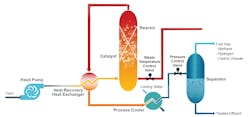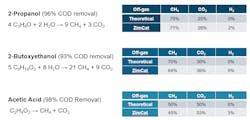Treating High-Strength and Toxic Wastewaters While Producing Methane for Fuel
Many industries, such as oil and gas refining, petrochemicals, and pharmaceuticals, employ complex processes that produce high-strength, hard-to-treat wastewaters. These types of wastewater have at least one of these problematic characteristics: high levels of biorefractory compounds; toxic compounds; halogenated organics; and aromatic or aliphatic hydrocarbons.
What’s more, their chemical oxygen demand (COD) levels can range widely, from as low as 1,200 mg/L to more than 300,000 mg/L. Furthermore, some process waters/wastewaters have high salt levels, especially chlorides, making cost-effective treatment especially challenging.
Existing treatment solutions for these high-salt wastewater streams include incineration or gasification. The former combusts the wastewater completely in the presence of excess oxygen at 1,100°C (2,012°F), producing carbon dioxide, water, and salts. The latter burns the wastewater using stoichiometric oxygen to produce carbon monoxide and lesser amounts of hydrogen. While these gases can be processed into more useful fuel gases, unfortunately both processes are expensive to maintain, and require backup units that consume capital, operating expenses, labor, and space.
Wet air oxidation is another treatment technology used for these high-salt wastewaters; however, if there are significant amounts of halogens present, finding appropriate construction materials can be difficult if not impossible.
To address the problem of hard-to-treat wastewater, Siemens researchers developed Zimpro® Catalytic Gasification technology (referred to simply as ZimCat). Derived from more than 50 years’ experience with field-proven Zimpro WAO/CWAO (Catalytic Wet Air Oxidation) technology, the ZimCat solution treats wastewaters that cannot be economically treated by other oxidation technologies while offering these additional benefits:
• Produces no solids, improving effluent quality for polishing
• Reduces COD loads substantially, helping to lower downstream treatment costs
• Reduces energy requirements by operating at lower temperatures
• Produces fuel gas, which can be used to offset operational costs
• Requires less space, given its compact footprint
ZimCat technology uses a heterogeneous catalyst to spur reactions similar to those that typically occur in steam reforming and gasification. These reactions occur in the aqueous phase as shown in Figure 1, so temperatures are much lower than what gas-phase gasification processes require. IWW
Siemens specializes in treatment solutions for wastewater discharge/reuse and process water treatment, in addition to spent caustic treatment. Learn more at new.siemens.com.

